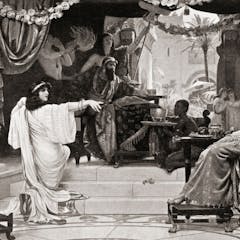
Articles on Mesopotamia
Displaying 1 - 20 of 21 articles

To protect their kings, ancient Mesopotamians discovered how to predict eclipses, which were associated with the deaths of rulers. This eventually led to the birth of astronomy.

Whether thousands of years ago or right now, fans have always created new stories based on familiar characters, weaving their own experiences into the tale.

Some of popular culture’s most famous ghosts and demons have roots in ancient Mesopotamia. What did ancient humans believe about the supernatural? And what stories did they tell?

From snake-like creatures with claws to jealous virgin ghosts, female monsters have long been a part of women’s lore. Such figures were Intimately tied to childbirth, sexuality and child mortality.

Generations of readers have experienced the frustration of reading fragments when trying to access classics of ancient Mesopotamian literature.

Millions of people around the world live on river deltas and are vulnerable when those rivers shift direction. A new study shows why and where these events, called avulsions, happen.

Natural landscape changes in the Nile Delta may have not only stimulated local take up of farming technologies, but might also have played a role in the emergence of the first “nation state”.

Beer was extremely popular in ancient Mesopotamia. Sipped through straws, it differed from today’s beer and was enjoyed by people from all walks of life.

Nebuchadnezzar was a warrior-king of the Neo-Babylonian empire. And now, Kanye West has written an opera inspired by him.

What caused the rise and then collapse 2,600 years ago of this vast empire centered on Mesopotamia? Clues from a cave in northern Iraq point to abrupt climate change.

Ennigaldi-Nanna is largely unknown in the modern day. But in 530BC, this Mesopotamian priestess worked to arrange and label various artefacts in the world’s first museum.

Enheduanna’s name means ‘Ornament of Heaven’. She wrote hymns and myths more than 4000 years ago, studied the stars and yet is almost entirely unknown in the present day.

Scientists have discovered new evidence of a drought that finished off the Akkadian Empire 4,000 years ago.

Unlike the Greek heroes, many Mesopotamian mythical figures have slipped into obscurity. An exception to this is their representation in comics, such as Gilgamesh, who served alongside Captain America as an Avenger.

Sex was central to life in ancient Mesopotamia. And the authors of Sumerian love poetry, depicting the exploits of divine couples, showed a wealth of practical knowledge about the stages of female sexual arousal.

Technology which located Mayan cities has been used to rediscover a southern African city from the 15th century.

Cuneiform was used for over 3,000 years in the Ancient Near East, but was only decoded in the 19th century. The writing form is still revealing amazing stories, from literature to mathematics.

More than 2,000 years ago, the Babylonians understood the cycle of eclipses. They also regarded them as signs that could foretell the death of a king.

Love, it is said, is a battlefield, and it was no more so than for the first goddess of love and war, Ishtar. Her legend has influenced cultural archetypes from Aphrodite to Wonder Woman.

From environmentalism to the meaning of life, the themes of the world’s most ancient epic are still remarkably relevant to modern readers.
